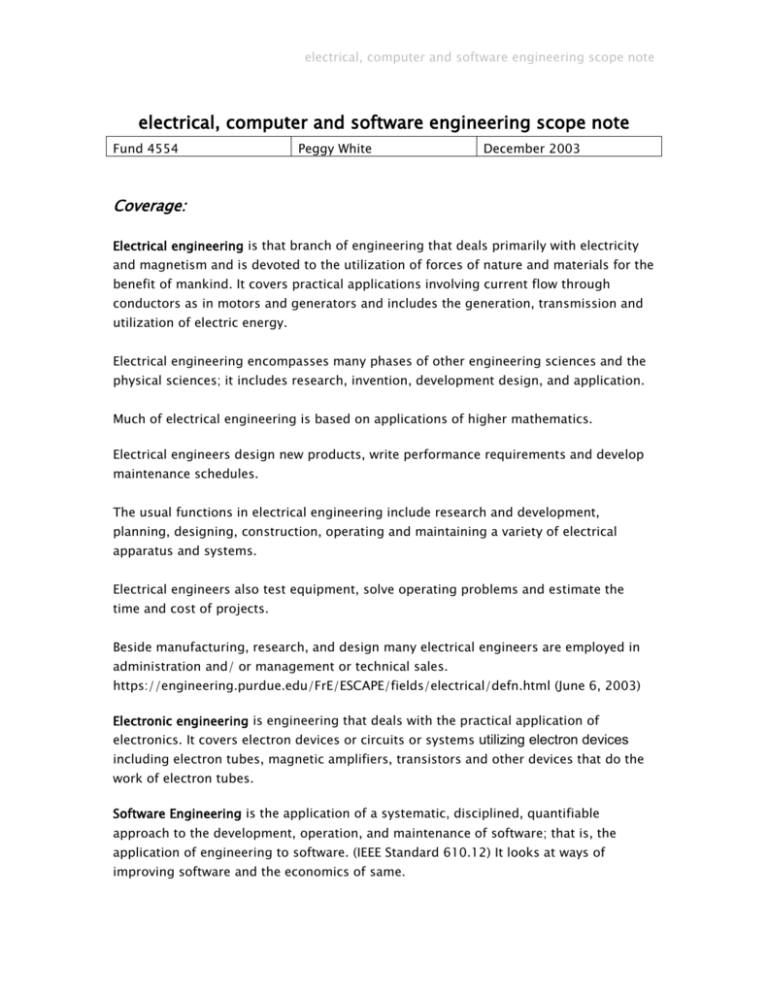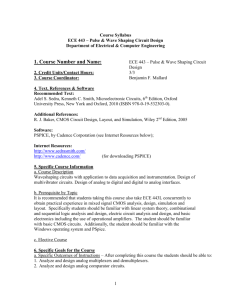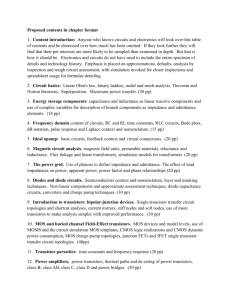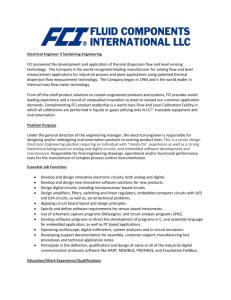electrical, computer and software engineering scope note
advertisement

electrical, computer and software engineering scope note electrical, computer and software engineering scope note Fund 4554 Peggy White December 2003 Coverage: Electrical engineering is that branch of engineering that deals primarily with electricity and magnetism and is devoted to the utilization of forces of nature and materials for the benefit of mankind. It covers practical applications involving current flow through conductors as in motors and generators and includes the generation, transmission and utilization of electric energy. Electrical engineering encompasses many phases of other engineering sciences and the physical sciences; it includes research, invention, development design, and application. Much of electrical engineering is based on applications of higher mathematics. Electrical engineers design new products, write performance requirements and develop maintenance schedules. The usual functions in electrical engineering include research and development, planning, designing, construction, operating and maintaining a variety of electrical apparatus and systems. Electrical engineers also test equipment, solve operating problems and estimate the time and cost of projects. Beside manufacturing, research, and design many electrical engineers are employed in administration and/ or management or technical sales. https://engineering.purdue.edu/FrE/ESCAPE/fields/electrical/defn.html (June 6, 2003) Electronic engineering is engineering that deals with the practical application of electronics. It covers electron devices or circuits or systems utilizing electron devices including electron tubes, magnetic amplifiers, transistors and other devices that do the work of electron tubes. Software Engineering is the application of a systematic, disciplined, quantifiable approach to the development, operation, and maintenance of software; that is, the application of engineering to software. (IEEE Standard 610.12) It looks at ways of improving software and the economics of same. electrical, computer and software engineering scope note Areas include software process reuse, process maturity modeling and reengineering, affect of software reuse on quality and productivity, metrics for software reuse, comparative metrics in procedure-oriented and object-oriented programming, requirements engineering and small software project development Teaching Focus There are three main programs, computer engineering, electrical engineering and software engineering. Common to all three are programming fundamentals, computer organization, signals and transforms, circuits, digital circuits, probability and statistics, and discrete mathematics. Electives common to all three include data base management systems, digital video processing, parallel computer architecture, digital signal processors, neuro-fuzzy and soft computing, wireless communications, digital communications, telecommunication and computer communication, optical fiber communication, digital filters. . Specialization begins in year three Computer engineering covers communication, operating systems, assembly language, real-time system design, control systems, compiler construction, and computer architecture. Unique electives include Field Programmable Gate Array (FPGA) and digital signal processing (DSP) systems and advanced control systems. Electrical engineering covers assembly language programming and interfacing, software development, control systems, digital system design, electronic devices and circuits, analog electronics and communications, electromagnetic fields, steady-state power systems. Unique electives include microwave circuits and antennas, transmission media, and power electronics. Software engineering covers computer communications, programming languages, database management systems, assembly language, real-time system design, principles of software engineering, and human and organizational aspects of software engineering, software metrics, software architecture, and compiler construction. Unique electives include computer graphics, software process improvement, and web engineering. Research Focus Bolded areas are linked to the areas of prominence and promise. However, there is a large amount of overlap among all the areas so many specific research projects may fit the criteria. Bioelectrics Bioelectricity is the generation and flow of electric current in living tissue. electrical, computer and software engineering scope note Research in this area covers the electrical properties of biological matter and materials. Primary focus is the development of novel devices for the biomedical and biochemical industries. Research seeks to unite advanced methods in the fields of semiconductor fabrication, control theory and dieletrophoresis. Dielectrophoresis is the physical principle, which governs the behaviour of neutral matter in non-uniform electric fields. Aspects of the research include biopolymer electrochemistry, silicon micro machining, chemical sensors and actuators and bioreactor control methods. (Kaler) Bioelectromagnetics Electromagnetism is the branch of physics relating electricity to magnetism. It is the magnetism produced by an electric current rather than by a permanent magnet. Research includes the Interaction of electromagnetic waves with the human body, both at extremely low frequencies (Power Lines) and very high frequencies (mobile communications). It also covers computations of the Specific Absorption Rate (SAR) and studies of antennas working in the close vicinity of the user. (Fear, Okoniewski) Biomedical engineering Biomedical engineering is the application of engineering technology to the solution of medical problems; examples are the development of prostheses such as artificial valves for the heart, various sensors for the blind, and automated artificial limbs. Research in the area focuses on biomedical instrumentation including the following, MEMS (MicroElectricalMechanicalSystems) based mechatronic devices and systems, biomedical signal and image analysis, noninvasive diagnosis, medical image and image analysis and neural networks. Specific areas of research include Signal processing and pattern classification techniques for noninvasive diagnosis of knee joint cartilage pathology by analysis of joint vibration (sound) signals Digital image processing, pattern recognition, and computer vision techniques for mammographic image analysis and computer-aided diagnosis of breast cancer Filtering, restoration, and reconstruction techniques for nuclear medicine imaging Artificial control of gastrointestinal motility, automatic infusion of insulin (artificial panreas), computer analysis of the level of randomness in electrophysiological signals Magnetic resonance imaging and image processing electrical, computer and software engineering scope note Image quality measures. Development of automated computer observers ROC (receiver operating characteristics) evaluation of signal and image processing techniques in clinical diagnosis. (Fear, Kaler, Leon, Mintchev, Rangayyan, Smith, Vigmond) Communications Research in this area focuses on communication over a number of devices and systems including radio, cellular radio, wireless and mobile radio, satellite and other types of telecommunications networks. Specific areas of interest include multiple-access, multiuser detection, detection and estimation techniques for cellular radio, multipath fading for indoor wireless and mobile radio and specific types of coding. Network research includes the use of fibre optics, queuing theory, interference, and super throughput local area protocols. (Eberlein, Irvine-Halliday, Johnston, Okoniewski, Potter, Sesay) Computer Engineering Research in this area primarily focuses on improving computer systems, performance and application. Areas include: Artificial intelligence, the branch of computer science concerned with enabling computers to simulate such aspects of human intelligence as speech recognition, deduction, inference, the ability to learn from experience and make inferences given incomplete information. Artificial neural networks, a form of computer artificial intelligence that use software developed on concepts understood from biological neural networks, to adaptively perform a task. Expert systems, application programs that make decisions or solve problems by using knowledge and analytical rules defined by experts in the field. Expert systems use two components, a knowledge base and an inference engine, which is that part of the system that matches input propositions with facts and rules, contained in a knowledge base, to form conclusions. Computer architectures, the physical construction or design of a computer system. Parallel processing, the method of processing that can run only on a computer that contains two or more processors running simultaneously. Programmers working with systems that perform parallel processing must find ways to divide a task so that it is more or less evenly distributed among the processors available. Distributed processing, that form of processing in which work is performed by separate computers linked through a communication network. It requires a highly structured environment that allows hardware and software to communicate, share resources, and exchange information freely. electrical, computer and software engineering scope note Compilers, which are programs that translate all the source code of a program written in a high level language into object code prior to execution. VLSI (very large scale integration) architectures. These architectures are very dense encompassing from 5000 to 50000 components. Computer-aided design of integrated circuits Goal-oriented languages Computer simulation for training of the handicapped (Bruton, Eberlein, Haslett, Norman, Smith, Turner) Control Systems Research in control systems is directed at improving optimum performance. It looks at ways of improving control systems through design modification, adaptation, and use of control methods in new ways Types of control systems include adaptive control, nonlinear control, variable structure control, real time digital control, microprocessorbased control etc. Many advances in this area have come as a result of improved computer technology enhancing the ability of the control system to handle increasingly complex variables and parameters. Adaptive control is a control method by which system control parameters are continuously and automatically adapted in response to variables to improve the performance of the host equipment. Nonlinear control theory explores systems where the relationship between the input and output signals is not linear and where as a result the behavioral possibility of the feedback loop can change. Variable structure control is a type of high-speed switching feedback control system used in non-linear situations, multivariable systems. It uses a combination of subsystems with fixed control laws to enhance the robustness of the system. Digital control refers to a control scheme in which the controller is a digital device generally a digital computer. It means that use can be made of much more advanced control logic. Measurement is made at discrete instants of time and data must be spatially discretized to allow digital handling. Microprocessor-based control systems are used in many domestic appliances. A microprocessor has the equivalent of the entire brain of a computer on a single integrated chip, which allows it to sense, interpret functions and respond to commands. electrical, computer and software engineering scope note Examples include microwaves, digital ranges, dishwashers etc. Research in this area involves the use an adaptation of new technologies such as fuzzy and neural network systems, thereby enhancing the efficiency and applicability of microprocessor based systems. Mintchev, Norman, Nowicki, Rosehart, Westwick Electronics The primary focus of research in electronics is on semiconductor devices and their application. Specific areas include CMOS Complementary metal oxide semiconductors. A combination of N- and Pchannel enhancement-mode MOSFETs (metal oxide semiconductor field effect transistors) on a single silicon chip connected as push pull complementary circuits. Their advantage is low quiescent power dissipation and high operating speed. Research in this area is focused on high temperature and noise limitations. Analog circuits, including nonlinear, low voltage, low power circuit design. A circuit is an interconnected group of active and passive electrical and electronic components that accomplish a desired function such as switching, amplification, filtering or data compression. Nonlinear circuits are circuits whose characteristics cannot be specified by linear differential equations in which time is the independent variable. Low voltage is an electromotive force of 24volts or less. Microelectronic RC-active and switched capacitor filter design. Active switched capacitor filters are filters that include an operational amplifier and feedback path to obtain selected filtering functions. CCD (charged-couple device) A storage device in which individual semiconductor components are connected to each other so that the electrical charge at the output of one device provides the input to the next. Research into applications includes CCD imager applications to spacecraft instrumentation systems nonlinear analog circuit development for pressure and temperature measurement instrumentation systems analog circuits for telecom applications microwave moisture measurement Isolated biomedical amplifiers Application of analog and digital circuits to instrumentation problems. New merged circuit structures; design, fabrication and modelling. GaAs ( gallium arsenide) digital IC design. Wafer scale integration of MOS (metal oxide semiconductor) and GaAs VLSI circuits. electrical, computer and software engineering scope note Packaging effects, ElectroMagnetic Compatibility and ElectroMagnetic interference problems Development of Software Package for Electromagetic Simulations. (Bruton, Haslett, Johnston, Kaler, Maundy, Mintchev, Norman, Okoniewski, Trofimenkoff, Turner) Image processing Digital image processing has major applications to many strategic areas such as computer vision, medical imaging and diagnostics, industrial inspection, remote sensing and seismic imaging. Research in this area focuses on enhancing images through various methods, including filtering, processing and restoration. Techniques include computed tomography in medical diagnosis and nondestructive testing, the use of the auditory system to process images, using a sonification procedure to convert images, the use of adaptive rather than fixed neighborhood techniques to enhance images, directional image analysis for quantitative studies, image coding and data compression to improve resolution, and digital signal processing for non-invasive detecting. Also under scrutiny is the enhancement of digital images by multidimensional signal processing, and twodimensional television image enhancement. (Bruton, Leon, Rangayyan, Vigmond) Power systems The central problem in power system generation is that of controlling the combined power output of the generators such that it matches the demand of the loads. Research in this area involves modeling and simulation of power system operation, to improve power system economics and planning. It includes various types of load flow and stability studies as well as advanced control methods such as fuzzy and neural network applications, real-time digital control, frequency control etc. Malik, Nowicki, Rosehart) Signal Processing Signal processing covers the processing of signals from physical sensors, radiofrequency, X-ray, ultraviolet, sonic, and ultrasonic transmitters and even natural sources to filter noise, improve the signal-to-noise ratio, amplify or otherwise improve signals for reception, retransmission, or conversion to another format. Filters and analog-todigital converters are examples of signal processors. Research in this area includes Random data analysis and the modelling and measurement of random physical phenomena. Estimation and detection theory. electrical, computer and software engineering scope note Spectral analysis and system identification problems Sampling and quantization theory. Characterization of large electrical machines using spectral analysis Fourier analysis and application. Fourier analysis is the process of determining the amplitude, frequency, phase, coherence functions correlation functions, power spectra, transfer functions and other functions of each sinusoidal component in a given waveform. Hartley analysis and applications. Digital signal processing (DSP). DSP is the processing of signals in digital-format technology, typically after conversion from an analog format. DSP techniques offer greater stability and accuracy than analog processing. They are used to analyze, enhance, filter, modulate or otherwise manipulate signals that originate in analog form. They offer better recovery for weak or fading signals and faster more efficient processing of systems such as sonar, radar and telecommunications. Adaptive Signal Processing One-dimensional and multi-dimensional digital filter synthesis, implementation and applications. CAD tools for digital signal processing. Biomedical signal analysis. Microprocessor systems Development of real time general-purpose programmable and microprogrammable boards for digital signal analysis. (Bruton, Mintchev, Leon, Norman, Rangayyan, Sesay, Smith, Vigmond, Turner) Software Engineering Software engineering includes theoretical and applied research on the effects of integrating a reuse policy inside a software development process, in terms of process maturity, productivity, quality, long term returns of investment, standards, effects on the market structure, relevant accounting techniques, and legal issues. Analysis of the effects of object orientation in terms of quality, productivity, predictability, return on investment; tools supporting software engineering over the Internet. (Eberlein, Mintchev, Rochefort, Ruhe, Smith, Wang) Very Large Scale Integration Circuit Design Very large scale integration pertains to a circuit containing between 2 x 104 and 106 transistors in design. A very large integrated circuit contains more than 1000 gates, elementary logic circuits that include a single transistor. Very large scale integration was preceded by large scale integration, medium scale integration and small scale integration. Small scale integration had less than 100 transistors in its design. electrical, computer and software engineering scope note Research in this area includes new circuit design techniques, verification methodologies and use in specific applications such as in field programmable gate arrays, BICMOS circuit structures, CMOS processes and two and three dimensional topological logic partitioning schemes etc. A field programmable gate array is a device containing many circuits whose interconnection and functions are programmable by the user. The CMOS process is a digital logic IC fabrication technology that combines NMOS and FET transistors on the same sub strate to form logic gates or memory cells. The BicCMOS process is an IC technology combining the linearity and speed of bipolar devices with the low power drain and higher density of CMOS. It is widely used for mixed-signal devices. (Dmitrov, Haslett, Jullien, Maundy, Nowicki, Trofimenkoff, Turner) Research Collections None Exclusions Excluded are general interest books on the Internet and its uses and also most software manuals such as Frontpage, Dreamweaver, and others on web design. Interdisciplinary Considerations There is considerable overlap between computer science and software engineering. In the case of software engineering both the Department of Computer Science and the Department of Electrical Engineering teach software engineering jointly. In the area of biomedical instrumentation there is overlap with the Faculties of Medicine and Kinesiology. There could be some overlap with the social sciences in the area of technology and impact on society. Finally all of engineering is connected. There is no current agreement with other funds. Selection Notes English Scholarly monographs, textbooks, conferences, journals and standards Last 10-15 years North America, Great Britain Duplicate heavily used texts Consider acquiring most IEEE or IEE monographs if money permits. electrical, computer and software engineering scope note Sources used. IEEE Standard Dictionary of Electrical and Electronic Terms McGraw Hill Encyclopedia of Science and Technology McGraw Hill Electronics Dictionary Wiley encyclopedia of electrical and electronics engineering







